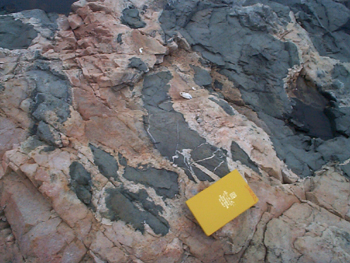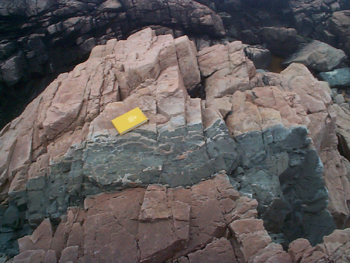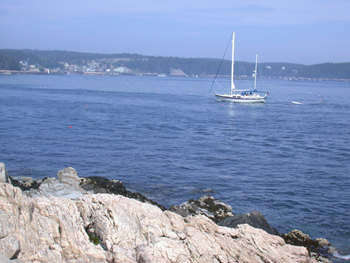The famous outcrops
Swans Island is an island just off the coast of Maine near Bar Harbor
and Acadia National Park. The rocks on Swans Island are part of the Avalon
Terrane, crust accreted onto North America during the Silurian and Devonian
(~438 to 410 million years ago). The eastern part of Newfoundland is also
part of the Avalon Terrane.
Swans Island and the Mount Desert Island region of Maine are home to some unusual outcrops of igneous rocks. The picture on the right illustrates bimodal magmatism on Swans Island. Similar pictures of bimodal magmatism from Mount Desert Island can be found in many geologic textbooks.
The granitic and mafic rocks are Late Silurian (~424 million years old) based on zircon dating. Partial melting of the mantle produced mafic magma. As the hot, mafic magma moved upwards, it melted the overlying crust (which is granitic in composition), producing granitic magma. This is an example of magma mingling, when two different magmas form and interact at the same time.
The mingling of the granitic and mafic magmas in Maine produced many unusual and varied outcrops. In some outcrops, the mafic magma intruded into the granite when the granite was still liquid. However, the granitic magma was cooler than the mafic magma. As a result, the mafic magma crystallized quickly into ellipsoid-shaped rocks called pillows (top, right picture). Basaltic magma erupting into water also cools and solidifies into pillows, which can be seen on the ocean floor.
In other places, the mafic magma intruded into the granite after it had cooled and crystallized. The mafic magma intruded into fractures in the crystalline granite forming mafic dikes (bottom, right picture). The mafic magma cooled more quickly on the edges of the dike where the mafic magma was in contact with the colder rock forming a chilled margin. As a result, the dike is much more fine-grained on the edges and more coarser grained towards the middle of the dike where the mafic magma cooled more slowly.
Also found on Swans Island are outcrops of mafic rock with granitic dikes intruding into the mafic material. Differential cooling occured on the two magmas because mafic magma solidifies at a higher temperature than granitic magma. Also, the middle of both types of magma cools more slowly than at the margins. This differential cooling produces a bizarre mix of outcrops. The outcrops with basaltic pillows indicate that the mafic magma was much hotter than the granite. But because pillows form when magmas erupt into liquid, the granite had not fully solidified. The mafic dikes form when the mafic magma intruded into granite that had already cooled and crystallized. Outcrops of granite intruding into mafic rocks occur where the mafic material had cooled and crystallized prior to the intrusion of granitic magma



